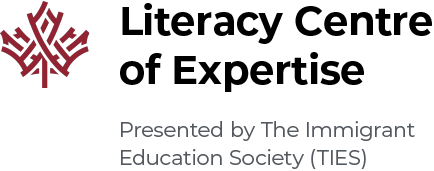
by Jeremy Wilson
Literacy Centre of Expertise Assistant
If you have been teaching EAL literacy for any amount of time or have looked through the CCLB’s ESL for ALL, you have likely come across the model known as Whole-Part-Whole (WPW).
Used in many areas where complex skills are being developed (from sports to budgeting to language learning), the whole-part-whole approach is especially relevant to teaching adult literacy learners as it provides for the use of both top-down and bottom-up strategies, can provide context and motivation for learning and also assist in planning instruction. Let’s take a look at what whole-part-whole is and why it is an effective approach for literacy learners.

What is whole-part-whole?
Whole-part-whole is an approach where learners are presented with an overall picture of the skill or task they are trying to learn (in any of the skills), then focus on the individual aspects or “parts” of that skill or task, and then return to the “whole” task and attempt to integrate both an overall understanding of the task along with the individual components they have practiced. In the context of language learning and literacy instruction, WPW is defined by ESL for ALL as an approach where “an authentic task is presented in its entirety and then broken down into individual components or parts that the learners work through systematically before the whole is addressed again” (Centre for Canadian Language Benchmarks, 2014, p. 12). Let’s take a look at each aspect of the process.

The First "Whole":
The first “whole” stage activates learners’ background knowledge about the topic or task and prepares them for new content (Swanson & Law, 1993). It also introduces a real-world context for the work with language they will do. This stage can involve discussion, videos and pictures and even field trips and is usually done as a whole class.
As an example, let’s look at the topic of grocery shopping. Learners may have expressed an interest in learning about food and grocery shopping in a needs assessment and reading a receipt may be an appropriate real-world task goal for this topic. The “whole” phase for working with this real-world task may involve a discussion where learners are asked where they buy groceries, what kind of groceries they buy, what they get back from the store upon purchase (receipts), and what kind of information is on a receipt (depending on the learners’ language levels and experience with receipts; we cannot assume they have prior experience with this, only find out if they do).
Asking these kinds of questions helps us discover the learners’ prior experiences with grocery shopping and receipts, what vocabulary and language about this topic they already possess, activates oral language necessary for literacy development, and draws on the skills and strengths they have outside of the classroom. Depending on the level, an instructor may display an example of a receipt and ask learners what they notice or recognize while in lower levels the instructor may read (and display) the whole text to the learners from the outset and have them listen to acquire basic comprehension of the text. After a basic grasp of the text is there, the instructor can move on to the “parts”.

Part(s):
“Parts” stages can be many and can involve any element of the task that is important for a more complete understanding of that task. It usually includes “specific language features” or literacy skills, such as those from the reading and writing continuums (including vocabulary, grammar, decoding, processing visual representations, comprehension, prediction, making outlines, editing, etc.), learning strategies, digital literacy skills, numeracy and others. Returning to our “reading a grocery receipt” real-world task above, this may involve a language focus on food vocabulary, sight word/decoding skills, scanning to find specific details, numeracy (prices/weight etc.), layout and features of a receipt or other “parts” in the form of skill-building tasks that help the learners successfully complete the real-world task of reading a grocery receipt.

The Return to the Whole:
After working with specific “parts” of the task, learners return to the “whole” and attempt to utilize the skills developed from working with the “parts” into a more complete understanding of the task. Going back to our receipt example, learners would now be presented with skill-using activities and assessment tasks where they practice incorporating all they have learned to complete the real-world task of reading grocery receipts (or in most cases an adapted approximation of such a task). The final whole may also focus on developing greater comprehension and/or fluency in the text or skill.
Why use whole-part-whole for literacy learners?
- Incorporate a range of strategies when used with reading: As stated eloquently in Bow Valley College's A Practical Guide to Teaching ESL Literacy: “Whole-part-whole is a good answer to the reading wars; it combines top-down and bottom-up approaches to learning to read, giving learners a range of reading strategies and an understanding that the meaning of the text comes from the individual letters (bottom-up) but also from the way they are combined together to make a text (top-down). Whole-part-whole is a balanced approach to literacy development” (2018, p. 199).
- Linking to prior learning and experience: Working with the “whole” prior to focusing on the “parts” helps connect any new information to the learner’s background experiences and prior knowledge. Even if some learners are being introduced to grocery store receipts for the first time, they likely have some experience with grocery shopping or food at the very minimum, so this can be used as a starting point. This also relates to motivation (discussed below) as “if their [literacy learners] life situations and experiences are used as a starting point for literacy development, learners will be motivated” (Centre for Canadian Language Benchmarks, 2014, p. 10).
-
Establishing context: The “whole” provides the necessary context for learning the “parts”. It is crucial that adult learners understand what they are learning about, why they are learning it, and how it will help them in their daily lives. The “parts” that can be focused on, such as using scanning as a reading strategy, decoding words with “-ing”, using periods at the end of sentences, using polite language etc., will likely be better understood if they are presented within the context of a real-world task.
For example, if I want to teach learners to read an email, they may need to understand specific vocabulary for emails (sender, recipient, subject, kind regards etc.), where to find such information in the email (layout), text conventions, how to scan for information, in addition to many other possible “parts”. But if learners do not understand what an email is, where or why they would use it or how it applies to their daily lives, any work on the parts may be of less value to them and less comprehensible. Many learners may have no prior knowledge about or experience with many concepts or things we take for granted in Canada, such as filling out forms or sending emails, so providing opportunities to discuss this context before delving into skills work is extremely important. - Motivation: Putting these smaller skills such as those mentioned above in a real-world context such as reading a table of prices, reading an email or writing an email can make the “parts” more relevant and worthy of the effort put in to learning them, but it also “reinforces the notion that each task is comprised of a series of smaller, more manageable steps (skill—building activities or smaller tasks) that help learners ultimately perform targeted real-world tasks” (Centre for Canadian Language Benchmarks, 2017, p. 31). This process of working through a large task by focusing each step at a time is a valuable learning strategy that learners (or anyone) can hopefully utilize in other life contexts.
- Planning: In addition to being used as an approach for presenting and teaching real-world tasks, the ESL for ALL Support Kit recommends that WPW be “applied to both long-range (module or unit) planning and individual lesson planning” (2017, p.31). For example, when planning a module, I will need to consider what real-world tasks have been identified as relevant to the learners (whole) as well as what skill-building activities related to language focus items, learning strategies, numeracy concepts, digital literacy skills, sociolinguistic elements are required (parts) and how learners will practice the real-world tasks and be assessed (whole). A daily lesson plan can be a microcosm of this in that there is a real-world task (such as reading a bank statement) that we will introduce (whole), various skill-building activities (parts) that we will undertake, and then finally practice in a skill-using activity (whole).
Personally, I had no prior experience with the whole-part-whole approach prior to teaching literacy learners. Having utilized it more and more often since then, I now find that using it helps me immensely with planning and delivering instruction. I had always focused on the “parts” but had often neglected the first “whole” phase and would be baffled by learner’s struggles with comprehending what they were supposed to do. In my experience, spending more time and attention on this first whole phase, as well as giving more consideration to what “parts” were needed to accomplish the task, has shown to be more effective in overall success for most learners.
What are your thoughts on whole-part-whole? How do you use it in your literacy classroom? Leave a comment below!
References and Further Reading
*To see whole-part-whole in action, check out the 20 hour synchronous course “An Introduction to the CLB: ESL for ALL.” There is a great video which shows a demo of W-P-W from start to finish in an actual classroom.
Bow Valley College – School of Global Access (2018). A Practical Guide to Teaching ESL Literacy. Retrieved from Bow Valley College website.
Centre for Canadian Language Benchmarks. (2014). ESL for Adult Literacy Learners (ALL). Ottawa, ON: Centre for Canadian Language Benchmarks.
Centre for Canadian Language Benchmarks. (2017). CLB: ESL for ALL Support Kit. Ottawa, ON: Centre for Canadian Language Benchmarks.
St. Peter’s Catholic Primary School (n.d.). Whole-Part-Whole Fact Sheet.
Swanson, R. A. & Law, B. (1993). Whole-part-whole learning model. Performance Improvement Quarterly. 6 (1), 43-53.

